
The enemy is in the house
The meek circus of the 50th Venice
Biennale
Stefano Pasquini
We're entering the age of quantity, and this year's
Biennale shows it. Whilst two years ago the participating
artists were about 300, this year they are over 500,
without counting all the unofficial participants at
Utopia Station and the other exhibits that overwhelmed
Venice in the atrocious heat of the opening days.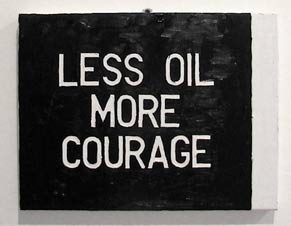
After three days of openings and press conferences and
parties, when I was about to leave Venice I thought to
myself: "a circus, that's what this year's biennale
felt like".
Which made me wonder if it makes any sense nowadays to
build up such a huge event, where the fruition of the
works become impossible due to the huge quantity of them:
we're talking about at least a thousand works of art to
view and judge and relate to. Yet it was still a
fulfilling experience; one that made me ponder much more
about the role of the curators than the artists
themselves. Which is, in a way, a paradox, as a paradox
is the fact that the Italian artists invited at the
biennale were not given any money for the production of
the work, no cash token for accepting to participate, no
catalogue. "What? No catalogue?" I asked one of
them when he told me so. "No, just a 20% discount on
the price". "Ok, here's my 40% press discount
for you". That was the least I could do to someone
who spent two weeks in Venice (ok, the hotel was paid
for) to install a work that was not paid by anyone, since
the artist in question doesn't have gallery
representation. 
"Dreams and conflicts" had a subtitle,
"the dictatorship of the viewer," and I didn't
quite like that: I don't think in any given time
contemporary art has been so distant from the spectators.
Of course, the figures tell you another story, but ask
people in the street and you'll find that no living
artist is known as much as the crappiest pop star or TV
presenter. These issues are dealt with in the catalogue
essay of Francesco Bonami, this year's curator. He did a
good job, but my main question is about quality; no
particular work stuck in my mind after the three days, no
masterpiece that moved me as much as Gary Hill's
installation two years ago. So many works resembled
pieces by other artists, and some were just blunt copies.
Is it possible that the overall quality of contemporary
art in the world is so low?
Yet his essay convinced me and made me think of Venice as
a utopist island that can make a change in a wrongful
world, a possible alternative or, in fact, utopia.
The arsenale was a diligent mess, work after work after
work in distinctive rooms, with a title and a clear
curatorial view, that peaked in what I really found
amusing: Hou Hanru's Urgency Zone. It starts off
with a funny installation by Yang Zhenzhong, "Let's
puff", a specular video installation where a girl
blows towards the other screen, making a cityscape
fast-forward. Then it starts, works all over the place,
pamphlets, videos projecting from all over the place, a
huge weird sculpture and a strange wooden staircase. 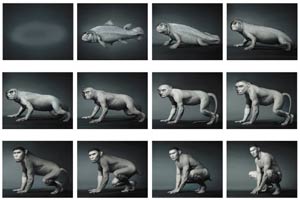 As I climb it the imponent
classical music peaks and I'm on top of the world, I'm
the master of the circus, a perfect reflection of today's
surreal world, with all these art people puffing and
sweating to hurry and not miss anything. Almost a
masterpiece.
As I climb it the imponent
classical music peaks and I'm on top of the world, I'm
the master of the circus, a perfect reflection of today's
surreal world, with all these art people puffing and
sweating to hurry and not miss anything. Almost a
masterpiece.
The Arsenale show goes on to finish in Utopia Station,
messier than anything else, yet quite disappointing. Only
Yoko Ono's little room, where you could stamp anywhere
the sign "imagine peace" with an inkpad was
nice and refreshing.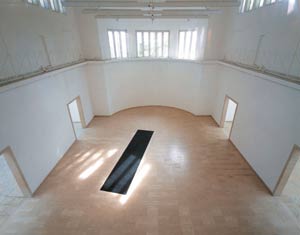
The Giardini this year was probably the most interesting
part of the Biennale. I particularly enjoyed the Korean
Pavilion, the Japanese one, Olafur Eliasson's strange
architectural world in the Danish Pavilion, but also
Egypt's Ahmed Nawar and his almost naďve installation
about violence and peace, Czech and Slovak Republic's
installation of an Olympic Christ by Kamera Skura and
Kunst-Fu, and outside the Giardini a mention has to go to
the Taiwan Pavilion with a well thought video
installation by Daniel Lee and photo-based works by Yuang
Goang-ming. Also the Kabakovs' show at Querini Stampalia
was great, if you go to Venice it's a must, and should
need a review of its own.
The Italian Pavilion wasn't particularly exciting, or
maybe just too crowded to be appreciated. Some high
quality works were there together with remakes of other
artists' works and a tiny little cherry on the massive
cake: Warhol's Screen Tests of 1964-66, with
Marcel Duchamp behaving just like Marcel Duchamp would.
Probably the most thought out pavilion of them all was
the US one. Fred Wilson's exhibition was all focused on
the presence of black people in Venice throughout the
centuries: from Veronese's paintings to the tacky racist
glass ashtrays everything was there to remind you that
not much has changed all this time: it's 2003 and
xenophobia is still part of everyday life. 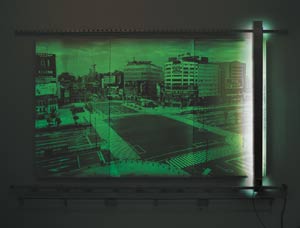
At this point I noticed where I was: Venice is the
capital of Veneto, the land of the xenophobic Northern
League Party, in a government coalition together with the
new fascists and Berlusconi's Forza Italia. And
we all know what Berlusconi thinks of other countries,
like the Arab world or the Germans, just to mention a few
of his gaffes.
This is when I realized the true strength of this year's
Biennale: in a world that is boldly going toward the
wrong path this is the utopical island: 500
people saying, all in their weird arty manner, no.

Useful Links:
www.labiennale.org
www.hungryghosts.net
www.krabbesholm.dk
www.odaprojesi.com
www.statelessnation.org
www.lovedifference.org
www.irelandatthevenicebiennale.ie
www.langsdelijn.net
www.querinistampalia.it
www.v2.nl/kinema-ikon
www.mae.es/bienalvenecia
www.britishcouncil.org/venicebiennale
www.cityrooms.net
www.bienale-benatky.cz


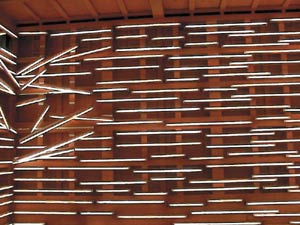
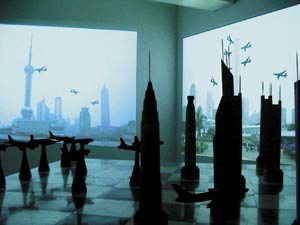

From top to bottom:
Athanasia Kyriakakos & Dimitris
Rotsios, "Intron", 2003, Greek Pavilion.
Rirkrit Tiravanija, "Less oil, more courage",
2003.
Vladimir Dubossarsky and Alexander Vinogradov,
"Under the Water", 2003, Russian Pavilion.
Stanislaw Drózdz, "Alea", 2003, Polish
Pavilion.
Daniel Lee, "Origin", 1999-2002.
Martin Kippenberger, "Luftschacht METRO-Net World
Connection", Venice, 1993/2003, Ph. Nic
Tenwiggenhorn, © Nachlass Martin Kippenberger.
Motohiko Odani, "Berenice", 2003, Japanese
Pavilion.
Yuan Goang-ming, "Human Disqualified",
2001-2003.
Andy Warhol, "Screen Tests", 1964-66.
Hou Hanru's "Zone of Urgency", exhibition view.
Kamera Skura and Kunst-Fu, "Superstart", 2003,
Czech Republic and Slovak Republic.
Pedro Cabrita Reis, "Absent names", 2003.
Chen Shaoxiong, "Various ways of
anti-terrorism", 2002-2003.
Fred Wilson, detail of installation at the U.S. Pavilion,
2003.
